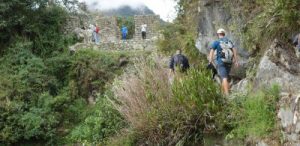The famous Inca site of Machu Picchu attracts thousands of visitors every day. People come from all over the world, eager to see the postcard images of the gorgeous city in person. Whether by train, bus or foot, the journey to Machu Picchu can be considered a modern-day pilgrimage. In fact, there is much evidence that Machu Picchu has been a pilgrimage site since it’s creation. The Inca Trail, still heavily trafficked today by hikers and tourists, provided a spiritual journey for Incas as they walked toward Machu Picchu.
Between the Sacred Valley and Machu Picchu, there are plenty of routes that would have been easier to build or walk than the Inca Trail. However, the difficulty of the trail and its closeness to mountains such as Veronica and Salkantay, suggest this trail was designed for religious purposes and special occasions (Cardinal 2017). Incas valued mountains as very holy places and have undertaken religious ceremonies and human sacrifices on mountaintops such as at Mount Llullaillaco (Reinhard and Ceruti 2010). Passing by massive mountains on the Incan pilgrimage was most likely an intentional spiritual decision. Religious ceremonies could have taken place at many of the archaeological sites on the route. Easier routes to Machu Picchu existed but were probably used for nonreligious purposes such as transporting llamas or goods.
Along the historical journey, some archaeological sites, like Runkuraqay (Figure 1), were resting points for travelers. Another spiritual aspect of the pilgrimage was walking through the Inti Punku (Figure 2), also known as the sun gate. Inti Punku is considered the gateway into Machu Picchu and walking through it offers the first view of the city. Once at the city itself, Incas might have participated in religious ceremonies at temples such as the Temple of the Sun, where Viracocha, the Incan sun god was worshipped (Lathrop 2019).
The modern-day pilgrimage on the classic Inca trail is very much marketed towards tourists and is a large source of income for many tour agencies in Peru. Everyone hiking the Inca Trail is required to travel with a guide and to buy a permit. Permits are expensive and need to be bought far in advance, as they are limited to 500 a day to reduce overcrowding of the trail (Whitman 2019). Nonetheless, people try to relive and reimagine the past treks made by spiritual Inca travelers as they hike for four days, ending with the entrance through the sun gate and descending into Machu Picchu. People today will spend much less time at the actual site of Machu Picchu than they spend getting there. Machu Picchu via the Inca Trail remains a popular and important pilgrimage site today, just as it was in the 15th and 16th centuries for the Inca.
Reference List
Cardinal, Nicholle. 2017 The History of the Inca Trail. Electronic Document, http://www.enigmaperu.com/blog/the-history-of-the-inca-trail/, accessed November 22, 2019.
Reinhard, Johan and Ceruti, Maria Constanza. 2010 Inca Rituals and Sacred Mountains: A Study of the World’s Highest Archaeological Sites. Electronic Document, https://ioa.ucla.edu/content/inca-rituals-and-sacred-mountains-study-worlds-highest-archaeological-sites, accessed November 22, 2019.
Lathrop, Jessica M. 2019 Temple of the Sun at Machu Picchu: History and Facts. Electronic Document, https://study.com/academy/lesson/temple-of-the-sun-at-machu-picchu-history-facts.html, accessed November 22, 2019.
Whitman, Mark. 2019 Inca Trail Availability and Permits. Electronic Document, https://www.machupicchutrek.net/inca-trail-availability/, accessed November 22, 2019.
Images
Figure 1:
The Inca Trail (Camino Inka): Day Three, Part I (Pacamayo to Qunchamarka)
Figure 2:
https://www.goshen.edu/peru/2017/07/05/sun-gate-ollantaytambo/
Further Readings
On the extended Inca Road System: https://www.ancient.eu/article/757/the-inca-road-system/
Tourism impact on Machu Picchu: https://www.chicagotribune.com/travel/ct-machu-picchu-tourism-boom-dangers-travel-0611-20170526-story.html



How do you feel about the tourism at Machu Picchu? What impacts does it have on the site itself? On the surrounding community?
Tourism in Machu Picchu has both good and bad side effects. On one hand, the nearly 2,500 people who visit the site each day fund most of the economy in the surrounding area, particularly the town at the base of the mountain, Aguas Calientes (Lama 2005). However, the large influx of tourists in the area has also negatively affected the ecosystems, polluting the rich biodiversity of jungles, rivers, and endangered animals like the spectacled bear. UNESCO has pushed for more regulations in the tourism industry to prevent ecological deterioration, but in general, people are valuing money over protecting the environment right now.
Works Cited
Lama, Abraham.
2005 Peru: Protecting Machu Picchu From Too Many Tourists. Electronic Document, http://www.ipsnews.net/2005/05/peru-protecting-machu-picchu-from-too-many-tourists/, accessed December 11, 2019.